Wiener Neustadt, Austria, July 10th - 31st, 1910
The first two aviation meetings in Austria

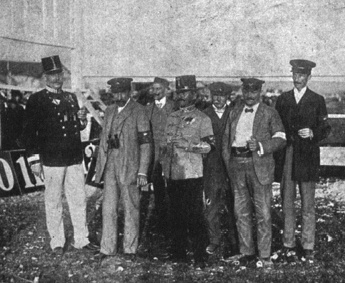
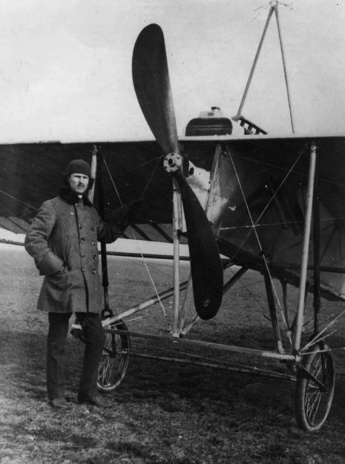
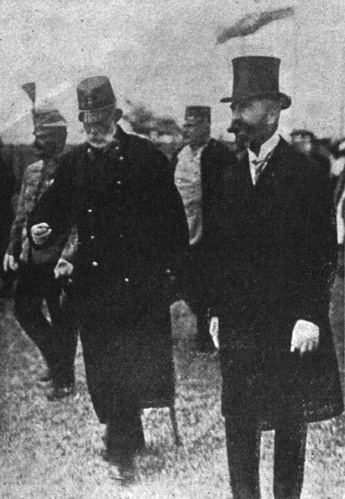

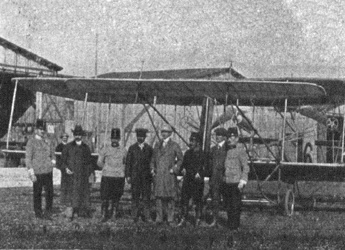
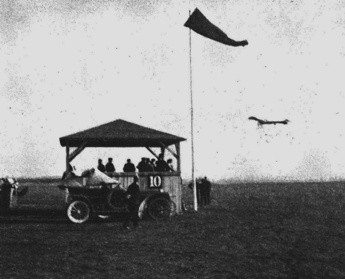



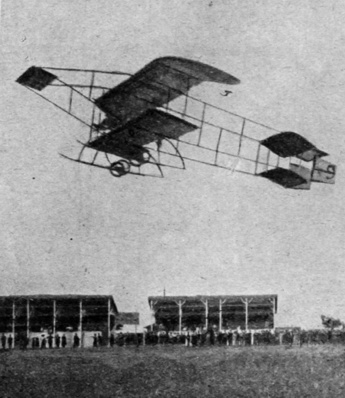
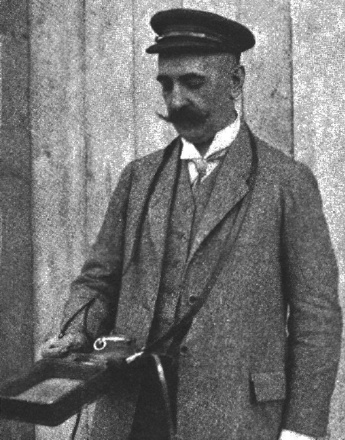

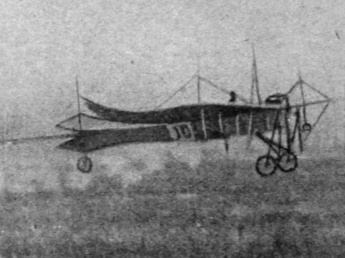

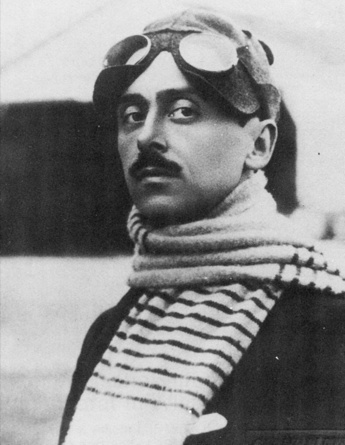
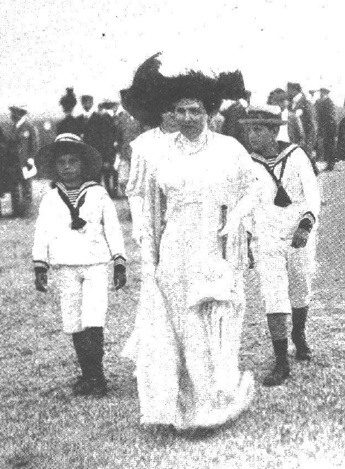
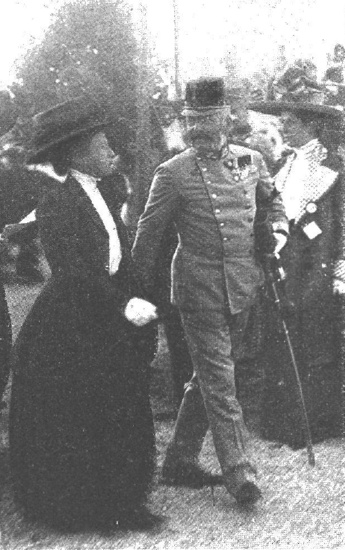
Wiener Neustadt is a town in the province of
Niederösterreich in eastern Austria, some 50 kilometres
south of Vienna. It is the home of one of the world's
oldest military academies, the Theresianische
Militärakademie, which was established by Empress Maria
Theresa of Austria in 1752. During the 19th century,
after the building of the Wiener Neustädter Kanal and
especially after the opening of the Südbahn railway in
1841, the city became an industrial town. Among the
factories were foundries, textile factories, clay ware
factories, a locomotive factory and the factories of
Austro-Daimler, the Austrian subsidiary of Daimler
Motoren-Gesellschaft. In 1910 it had around 32,000
inhabitants.
On June 11, 1909, the Stadtgemeinde (municipal council)
of Wiener Neustadt, headed by its mayor Franz Kammann and
inspired by the Reichstag deputy Victor Silberer and
Hauptmann Franz Hinterstoisser, commander of the
Militär-Aeronautischen Anstalt, decided to dedicate some
barren heathland on the Steinfeld, northwest of the town,
to the building of an airfield. They also approved the
construction of a hangar, which was completed at the end
of July. On July 26, Igo Etrich rented the first hangar
and the municipality built more, eight of them by the
winter and twenty-three by summer of 1910. Archduke
Friedrich sponsored the construction of a two-storey
building which would serve as royal loge and
café-restaurant. It came to be known as the
"Kaiser-Pavillon".
I. Preisfliegen, July 10th - 24th
In the beginning of June 1910, the Stadtgemeinde proposed to the Österreichischen Aeronautischen Kommission to hold a contest on the airfield on the first three Sundays of July. It would only be open to entrants that were based at the Wiener Neustadt airfield. Prizes would be offered for speed, altitude and total flight time, and there would also be a "Jungfliegerpreis" ("Junior prize") for the longest flight by a pilot who hadn't entered any of the other contests. The sporting arrangements would be handled by the Österreichischen Automobil Klub. The proposal was accepted, but it was decided to postpone the contests by one week, resulting in the somewhat unusual schedule of a meeting over three successive weekends, with flying only on the 10th, 17th and 24th of July.On the Wednesday before the meeting the town invited the Vienna press to a tour of the airfield and the hangars in order to ensure positive coverage in the newspapers. Eighteen of the hangars were occupied by more or less established airplane builders. The local Autoplan-Werke with their Warchalowski and Pischof designs and Etrich with their "Taube" and "Möve" monoplanes were the most proficient of the Austrian builders, but there were no Pischof monoplanes on display, since Alfred von Pischof had brought the two available machines to the Reims meeting. The Voisin of baron Constantin von Economo and the Wright-Knoller of industrialist Robert von Lieben, piloted by Vincent Wiesenbach and Hauptmann Stephan Petróczy von Petrócz, had also made successful flights. The Farman that Adolf Warchalowski had brought to the airfield in January was still there, now owned by the army and flown by Hauptmann Wilhelm Booms, commander of the Wiener Neustadt aviation station. Most of the remaining machines were new and untested. The mayor and a couple of the flyers made speeches, a buffet was served and later in the evening Karl Illner, in the Möve, Adolf Warchalowski, von Economo and Wiesenbach made short flights.
Fifteen pilots had entered the contests, but in the end six of them would not even try to fly. During the last weeks two more sponsored prizes were added, bringing the total prize fund to 6,800 Kronen, one of the smallest of the season and less than two percent of that of the Budapest meeting two months earlier. The additional prizes were the "Tüchtigkeitspreis" ("proficiency prize"), for the pilot who made the longest flight on the least favourable day, and an unusual prize for the eight-lap flight with the biggest time difference between the first four fast laps and the last four slow laps.
Sunday 10 July
The morning of the first day was windy and the mountains around the airfield, the Hohe Wand, the Wechsel and the Schneegebirge, were cloaked in heavy clouds. Around noon there was a short rain shower. Flights looked unlikely, but the trains from Vienna and other neighbouring towns were still overloaded with people going to the airfield. At three o'clock a cannon was fired to indicate that the meeting started. The white flag flew on the timers' pavilion, indicating that there probably would be flying, but it was still far too windy. The fenced-off areas for paying visitors, the hangar area and the more expensive "Klubraum" around the grandstands and the Kaiser-Pavillon started to fill with elegant people from the chic Vienna high society, nobility and representatives of the sporting world. The Stadtkapelle played music. Some of the locals with smaller budgets had made a little camp with improvised tents outside the fences on the side of the airfield facing the town.
Towards half past four a heavy rain shower with some hail fell and forced the visitors to flee to the hangars. It passed quickly, though, and the wind decreased. The first member of the court arrived, Archduke Rainer. He arrived at five o'clock, greeted by the national anthem and immediately settled on the first floor of the Kaiser-Pavillon. He was later followed by Archduchess Maria Josepha and her fourteen-year old son Archduke Maximilian.
At a quarter to six the red flag announced that flights will take place. The numbers of the flyers were displayed on the timers' pavilion and the contests competed for were indicated by coloured boards: White for endurance, blue for altitude, red for speed and yellow for the Jungfliegerpreis. The first number to be shown was Illner's number 10. He climbed to the seat of the Taube, dressed in a brown suit that according to a reporter "combined the clothing of an automobile racer, a diver and an eskimo". He had to fight the still turbulent winds during his short test flight of 3:39. He was followed by Adolf Warchalowski, who flew two and a half laps at good altitude and landed smoothly after nine and a half minutes, his engine not running well.
The third to start was von Economo in his Voisin biplane, which due to the box-like surfaces was likened by other pilots to a small apartment, with a room, a closet and a kitchen. He took the turns with perfect ease and landed after a two-lap flight of 5:37, enthusiastically applauded. Karl Warchalowski was the first of the junior fliers to make a flight, which lasted for a little over two minutes. Wiesenbach took off, going for the endurance prize. Wilhelm Booms started in the army Farman. After a long take-off run he stayed in the air for 51 seconds, before landing at the first turn.
Around a quarter past six, the numbers of Illner and Adolf Warchalowski were once again displayed. They both entered both the altitude and endurance contests. They quickly climbed high, Illner's Taube first off the ground, followed by a thick trail of blue smoke and the smell of castor oil. By now, the sun had won over the clouds and the circle of mountains around the airfield shone in the evening sun. Wiesenbach still circled around the field in his Knoller-modified Wright, its aluminium paint gleaming like silver in the sun, while the machines of Illner and Warchalowski soared high above, "chasing each other like birds". Illner passed at an altitude of around 200 metres almost vertically above the spectator areas. The reporter of the "Wiener Luftschiffer-Zeitung" wrote lyrically: "The sun shone on the brass of the machine, making it gleam like gold, the wings were sharply profiled against the deep blue sky, their structure visible through the translucent fabric like feathers - a grandiose and fairy-tale beautiful view, this pigeon, encircled by a heavenly halo, soaring above like the Holy Ghost of the twentieth century".
Karl Warchalowski again took off in the second "Autobiplan", chasing his brother during half a lap and landed after six and a half minutes. Then von Economo also took off, making it five machines in the air. He intended to go for the speed prize, but could only cover one of the required two laps. By now it had become completely calm, and everybody was queuing to fly. Illner had landed after eighteen minutes, but Adolf Warchalowski, who had landed and taken off again, and Wiesenbach were still running for the total flight time flight. Wiesenbach would remain in the air for 48 minutes, the longest flight of the day. Karl Warchalowski started a third flight, which would last for five minutes.
Then a couple of the unexperienced designer-pilots came out to test their machines, Rudolf Simon with his biplane and Paul Fiedler with his monoplane. Simon managed to lift off, but could only stay in the air for five seconds. Fiedler did slightly better, but landed after fifteen seconds. Their efforts were followed by Max Klug, who briefly managed to get his self-built monoplane into the air, but then rolled on the ground all the way around the course, earning himself the nickname "Laufkäfer" (ground beetle).
Illner took off for a third flight, this time in the smaller Möve. It had a landing gear with only a single wheel, which made the take-off a bit wobbly, but he managed the difficult situation and quickly left the ground. He climbed higher and higher during a flight of almost half an hour, showing his complete control of the beautiful monoplane. He even once passed the grandstands standing up in his machine instead of sitting on his seat! Von Economo also made a third short flight, this time for four minutes. Booms and Fiedler tried again, but they only made short jumps, neither of them improving on their previous efforts. Adolf Warchalowski took off for a fourth time. Karl Warchalowski made a fourth flight, this time impressing the spectators with some roller-coaster flying, going up and down in a wave-like pattern. Wiesenbach landed after his second flight after getting an insect in his eye, adding fifteen minutes to his total flight time and putting him in second place in the endurance contest.
At eight o'clock, when a cannon shot marked the end of the day's official flying and the last visitors were leaving, Adolf Warchalowski was still circulating, high up and far outside the airfield, once passing over the hangars.
Adolf Warchalowski's last 26-minute flight had secured him the lead in the total endurance contest. He had also taken the lead in the speed contest by covering the ten kilometres in 9:28 and made the highest flight (296.41 metres), but the altitude result was provisional, since it was claimed that the altitude was reached after eight o'clock. Karl Warchalowski's best time of 7:30 was enough to claim the lead in the Jungfliegerpreis.
Altogether, nine competitors had made 23 flights during the first day. No records had been beaten, but once the weather had improved had got to see in total almost four hours of flying, without the slightest mishap. This was despite allowing unexperienced flyers in untested machines to participate, something that was discouraged by the FAI and criticised in the aviation press. They also condemned that several flights that had been made above crowds and hangars, endangering the people at the airfield.
Sunday 17 July
The second day started sunny and at it least in the town completely calm, but when it was time to start flying a brisk breeze was blowing over the heathlands. This was a pity, since the news of the brilliant first day and the promising morning weather had attracted enormous crowds. The traffic around the airfield was chaotic. Around 10,000 people passed the turnstiles of the hangar area, despite competition from big meetings at the Baden and Kottingbrunn racecourses between Vienna and Wiener Neustadt, and that was only a small fraction of the crowds that despite the burning sun wandered over the heathland between half past three and half past four to camp along the accessible edges of the airfield.
As always, the newspapers carefully reported the presence of the members of the court and other prominent people. The list of more than 100 names filled half a column in the "Wiener Neue Presse". Archduke Rainer was there again, this time together with his wife and from later in the afternoon also his mother, Archduchess Blanca, and a couple of the younger of her ten children. They were accompanied by Archduke Friedrich with wife and daughters.
There had been a couple of improvements at the airfield: The boards announcing the pilots and contests had been enlarged in order to more visible and the field was now patrolled by mounted soldiers of Wiener Neustadt's 15th Dragoon Regiment. At four o'clock, when the white flag was hoisted on the timers' pavilion, the wind speed was still 5-6 m/s. The mountains around the airfield were hidden by mist from time to time and the weather didn't look promising.
At a quarter past five, just when the national anthem announced the arrival of the Archduchess Blanca, the red flag was hoisted. Adolf Warchalowski took off to compete for speed and endurance. The wind had decreased a little and the threatening thunder clouds had passed, but they were still towering like a wall in front of the mountains. Just as the engine of Warchalowski's machine started to roar there was a flash of lightning. He took off after a short roll, far before reaching the white start/finish line that ran across the field. The gusty wind still troubled him, even at heights of 30-40 metres. The machine was blown around by the turbulence, and the pilot decided to land already after two and a half laps, with a flight time of 5:36. Minutes later, he was followed by Illner, who made a short test in the Taube. During the landing he swerved into the fence that ran around the airfield. A wire was ripped off and the left wing was slightly damaged. It was feared that the damage would keep him out of action for the day.
Illner soon came out again, in the Möve. He had announced in advance that it would only be a test flight. The machine rolled past the start/finish line and after a long run finally left the ground, but it didn't gain any altitude. He continued along the course, close to the ground. At the northwest corner he touched down and then, sometimes flying, sometimes rolling, completed the lap back to the timing pavilion, where he shut down the engine. The reason for the problems was that the single-wheel main landing gear had been replaced by a normal two-wheel setup during the week. Illner had crashed the single-wheel machine one month earlier when one of the wing-tip wheels collapsed and after the troubles of the preceding Sunday they had apparently realized that it was a failed experiment. The new landing gear had changed the centre of gravity of the machine, and it hadn't been tested before this flight.
The next starter, at 17:38, was von Economo in his Voisin, who was only flying for the endurance contest. His take-off was impressive. The propeller had hardly begun to turn before the machine lifted off, and when he passed the grandstands the machine was already several metres above the ground. The wind increased and the signal flags fluttered, the airplane bobbed and weaved, but its brave and cool-headed pilot didn't lose his control. He elegantly rounded the turns, climbed higher and higher and then returned in a beautiful descent in front of the grandstands. The loud thunder that was heard from the wall of clouds around the airfield was mixed with the applause.
While von Economo finished his second lap Wiesenbach started an endurance and speed flight in his Wright-Knoller biplane. He couldn't leave the ground until he had passed the start line and had to be satisfied with a flight time of 4:19.4. Von Economo continued his flight. Lap after lap he was encouraged by the spectators, who were grateful for the entertainment that it seemed only he was able to provide on this windy day. When he masterfully turned at the end of the fifth lap and passed the grandstands at an impressive altitude, the cheering got even louder. So completely in harmony with its element, even the "flying box" looked beautiful!
Wiesenbach took off again, this time trying for the endurance and speed contests. After completing a quarter of a lap, he slipped inside a pylon and came very close to the ground, but he climbed quickly again and followed von Economo to complete a lap. Von Economo displayed some showmanship by gliding down from around twenty to only two or three metres above the ground right in front of the grandstands. He quickly climbed again and landed smoothly after completing six and a half laps. Wiesenbach landed immediately afterwards. Then Adolf Warchalowski made a flight with a passenger on board, but only completed half a lap. Booms also tried to make a passenger flight, but without success.
At around a quarter to seven a long pause started. The clouds moved closer, the wind ripped the flags and some drops of rain fell. The thunder clouds soon retreated into the background and the lack of flying offered the friends of nature a chance to watch the white lightnings against the leaden clouds, with a rainbow to the left and the Puchberger Wände of the Schneeberg in strangely sharp light to the right. Most of the spectators gave up the hope of seeing any flying and left the airfield, even though the red flag stubbornly stayed up, and indeed, there would be some more flying in the end.
Around half past seven von Economo's machine was rolled out from the hangars. He again started an endurance flight. After a quick take-off he soon climbed to a considerable altitude, but he landed in front of the timers' pavilion already after half a lap. Then Adolf Warchalowski started an endurance and speed flight, which lasted for 20 minutes. While he completed his fourth lap Illner came out with his "Taube", which had been repaired, to compete for endurance and altitude. But the "Taube" didn't do much better than the "Möve". It only managed to leave the ground for a short while. Von Economo once again started an endurance flight while Warchalowski completed his seventh lap. In front of the grandstands a race developed, from which the Voisin pilot emerged as winner. Illner took off again, and against the background of the thunder clouds the three white machines crossed the sky in V formation. Then they flew three abreast, the Autobiplan outside, the Voisin on the inside and the "Taube" in the middle. Illner landed almost immediately, followed by Warchalowski, who had flown eight and a half laps, and at last Baron von Economo touched down. Soon thereafter the black flag and a cannon shot announced the end of the day's flights.
During the day, four flyers had made nine official flights, that only counted towards the endurance prize. The longest flight was von Economo's first flight, which lasted 33:43.4, but Adolf Warchalowski had increased his lead in the total flying time contest. Illner was only credited with 30 seconds of officially timed flights. Because of the windy conditions there hadn't been any improvements in the altitude and speed contests.
The more experienced flyers had shown that they could handle windy conditions and the novice flyers who didn't try only displayed common sense. The vice-president of the Austrian Aëro-Klub emphasised the record crowds of the day, and stated that von Economo was in a good position for the Tüchtigkeitspreis, for the longest flight on least favourable flying day.
Sunday 24 July
This should have been the last day of the meeting. However, it had rained all through the night and the morning and the weather looked so miserable at midday that the officials decided to call the day off. It was announced on posters at the cash desks of the railway stations in Vienna that the contests would not take place on this day, but that they were suspended until the next Sunday, July 31st, and that tickets that were already bought would be valid on the 31st.
A large number of visitors were already at the airfield, however, including the minister of War, General Franz Xaver Freiherr von Schönaich. The lack of flying enabled him to make a long tour of all the hangars, guided by the flyers and organizers, before deciding to leave the airfield at half past five. He explained that if he had stayed, he could have tempted the pilots to fly, and since the wind speed was still around 10 m/s he didn't want them to take any risks. During the afternoon the skies brightened, but the winds only decreased slowly. First towards half past seven the few spectators that had endured in patience got something to watch, as Illner and Karl Warchalowski each made a successful flight.
During the evening the flyers, the members of the sports commission and the airfield committee had a meeting, chaired by Bürgermeister Kammann. The flyers protested the postponement of the last day, since the rules stated that the contests would be open on the originally intended days, regardless of the weather. In respect of this, it was decided that the contest was closed on July 24th. The results after the second day were final, except Adolf Warchalowski's highest flight on the first day, which was ruled to have been made after the end of the allowed flying time. This meant that the altitude prize went to Illner, who reached 184.78 metres on the first day. For the same reason, Warchalowski's total flying time on the first day was reduced by some seven minutes, but he still won by a large margin. The Tüchtigkeitspreis was awarded to von Economo for his flight on the second day.
II. Preisfliegen, July 31st
The organizers of course wanted to make good on the promise to the ticketholders for the last day. At the same time, the pilots had, quite justifiably, refused to simply postpone the last day of the meeting. The solution was to quickly organize a new meeting, with new contests and new prize money. This required quick action by all parties, but the Österreichische Aëronautische Kommission was not very responsive. Its president received the necessary request only on Wednesday morning. In the same afternoon the accompanying detailed proposal arrived, and at nine o'clock in the evening an urgent telegram from Wiener Neustadt. According to its rules, the commission only met on Mondays, and the invitation to the meetings must be received by the members three days in advance. The new event for which permission was requested would take place four days later, already on the Sunday, so a regular invitation to a meeting discussing the event was of course out of the question. The organizers in Wiener Neustadt had already announced the meeting and put up posters, and the aviators besieged the president of the commission with requests to exceptionally let the meeting go ahead.It was only after considering that the new meeting was merely a replacement for the cancelled third day of the first meeting , and that the municipality of Wiener Neustadt would have to pay damages to ticket holders and others that had been told the meeting would last for three days, that its president quite extraordinarily, without a meeting of the commission, decided in the commission's name to allow the meeting to be held. It was clearly stated in the decision that such late forced and extraordinary action would never be allowed again. It was decreed that in the future applications for holding of aviation meetings had to be made at least fourteen days in advance of the meeting. Furthermore, no doubt because the previous meeting hadn't obeyed the FAI's instructions, the president required that in the future, only pilots who had been granted an Austrian pilot's licence would be allowed to participate in contests. With this, the second meeting could go ahead.
There were some changes to the rules and the contests. As prescribed by the commission, entry was limited to licenced pilots. Shortly before the meeting Karl Warchalowski and Wilhelm Booms, who had at the previous meeting been considered "Jungflieger", had passed their examinations and been granted licenses. The contest rules differed in some respect from the first meeting. There was of course no "Jungfliegerpreis". The endurance prize would not be given for the longest total flight time of the meeting, but for the longest non-stop flight, with a minimum time of 30 minutes. There would be a similar endurance contest for officers, who could only compete for an honorary prize, and for which the minimum time was five minutes. A minimum requirement was also decided for the altitude contest, where 100 metres would be required. The speed contest would be for the shorter distance of one lap. There would be a prize for passenger flights, for the longest flight of at least three kilometres with the shortest take-off. The winning of prizes would also be made more difficult by the requirement of a minimum number of contestants: For the endurance and passenger prizes at least three and for the altitude, speed and officers' prizes two. Several of the prizes were donated by sponsors.
Sunday 31 July
The weather looked good from the town, with a cloud-free sky and almost complete calm that promised perfect conditions, but at the airfield it was quite windy. The crowds were smaller than on the previous days, but the Südbahn still claimed to have transported 6000 visitors. On the side of the airfield that faced Wiener Neustadt there were still a lot of visitors, but the "Klubraum" and the other areas restricted to paying visitors were less popular. It seemed like most of the crowds were locals from Wiener Neustadt, and that they were mostly satisfied with the free areas. Among the guests were Duchess Antonia von Parma and her daughters, Prince Don Jaime von Bourbon, Prince and Princess Hugo von Thurn und Taxis and several ministers and high-ranking officers.
At four o'clock, when the cannon shot announced the start of the meeting, a strong wind was blowing across the airfield, stronger than on the first two flying days. To make things worse, it was blowing from the southeast, from the Wiener Neustadt direction, which meant the flyers had the wind from behind during the take-offs. There was not much hope of calmer weather until the evening.
The visitors, who realised that they couldn't expect flying until the evening, spent their time walking in the hangars, which always had something interesting to offer. There were a couple of novelties: The machine built by Otto Hieronymus for Laurin & Klement, a completely Austrian product, since the engine also was produced by that company. There was also the unusual "Minimus" biplane of Hans Rittmeister von Umlauff, which Jakob Lohner & Co. had built to his design. In front of hangar No. 19, which contained the Voisin of Count Alexander Kolowrat, there was always a group of curious people. They were apparently less interested in the machine than in the amusing spectacle that the owner of the hangar, who had made it quite home-like in there, provided as pastime: In the door there was a monkey, who played tricks with a cute little dog. In the hangar of Igo Etrich one could see Illner busy at work repairing some damages that the Taube had suffered during a practice flight. Unfortunately, it wouldn't be able to make as fine flights as three weeks earlier.
Towards seven o'clock the winds finally reduced and quickly, one after the other, the two Warchalowski Autobiplans were pushed out onto the airfield. The first to take the seat was Karl Warchalowski, who started for endurance and altitude. Adolf Warchalowski took off some minutes after him, only for the speed contest. He landed after completing a lap, while Karl Warchalowski circled the field for almost half an hour, all the time climbing higher and higher. Soon after Adolf Warchalowski landed, von Lieben's Wright-Knoller machine appeared. This time it was not Wiesenbach at the controls, but Hauptmann Petróczy, who shared the machine, which von Lieben had put at the disposal of the army. He was going for the officers' prize. With his regular slow flight at three to four metres off the ground he dominated the field. He stayed in the air for more than three quarters of an hour, and the longer he stayed in the air the more he gave the spectators the impression of solid, practical air travel. Every time the machine passed the spectator areas, the pilot was heartily cheered.
Meanwhile, Adolf Warchalowski made another speed flight, making it three machines in the air, but unfortunately it was now too dark for the spectators to be able to fully enjoy the spectacle. Karl Warchalowski had by now reached an altitude of at least 100 metres. On one lap he drifted off the course in front of the grandstands and flew above the crowds, a mistake for which he was reprimanded by the officials. Adolf Warchalowski also approached the borders of the public areas, but on purpose - he spread blue ribbons with the text "Gruß aus der Lüften" (Greetings from the air). Karl Warchalowski flew one more lap, but then his engine stopped right in front of the timers' pavilion. It looked like a difficult moment, since the machine dropped quickly, but the pilot was in full control and finished with a beautiful glide and a smooth landing. His flight time was 26:19, the second longest of the day, and he had reached a height of 112.71 metres. The engine problems robbed him of the civilian endurance prize, since he didn't reach the minimum 30 minutes, but the flight won him the altitude prize. A Corporal Westermeyer of the 15 Dragoon Regiment, who should have served as an orderly for the altitude measurements, had been injured when his horse was frightened. He fell off and the horse stepped on his head and he had to be removed unconscious, but the organizers had apparently found somebody to replace him.
Booms made a flight on the Farman. It lasted only a little above two minutes, but it saved the officers' prize for Petróczy, since the requirement of two competitors was fulfilled. Petróczy landed after 46:20, by far the longest flight of the day. Then Illner took off in the Taube for the endurance and altitude prizes. He landed again already after a little more than eight minutes without getting very high, but he had prepared a surprise for the spectators: He released three real living pigeons from the machine during his flight!
During the last minutes of the meeting Adolf Warchalowski took off for the passenger prize, with his wife Anna on board, and landed after 4:36.8. Wiesenbach, who also tried for the passenger prize, only reached 49 seconds. In total, six pilots had made eight official flights. After the end of the official flights von Umlauff made a successful flight in his "Minimus".
Conclusion
Although featuring most of the accomplished Austrian flyers and constructors these were a couple of low-budget local meetings. No sensational flights were made, and the meetings were hardly reported at all in the French and British aviation press. The weather hadn't been kind to the organizers, but the Austrian aviation press hailed the first day as a great success, comparing the native flyers favourably with the highly paid foreign primadonnas of the extremely expensive Budapest meeting. They also expressed pleasure that there had been no accidents. The following days hadn't been as successful, and after the success of the first two days the crowds on the last day were below expectations. The meetings had run well and the organization, the officials and the town of Wiener Neustadt were praised. There would be several more meetings at the airfield. It is still used, and it is one of the oldest active airfields in the world.


